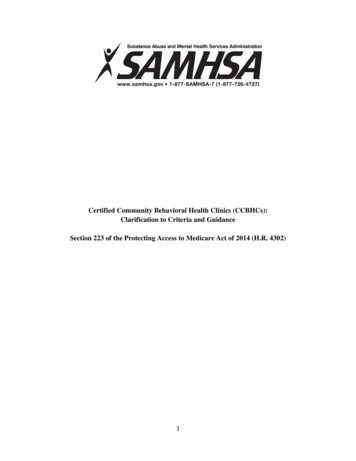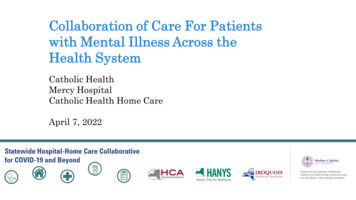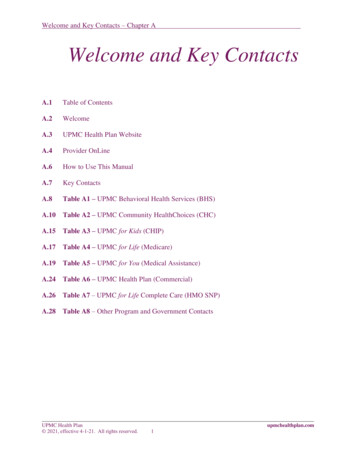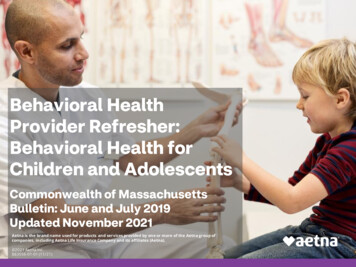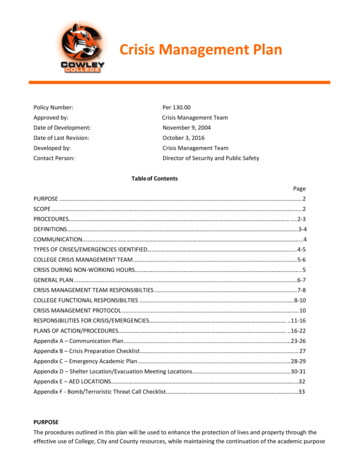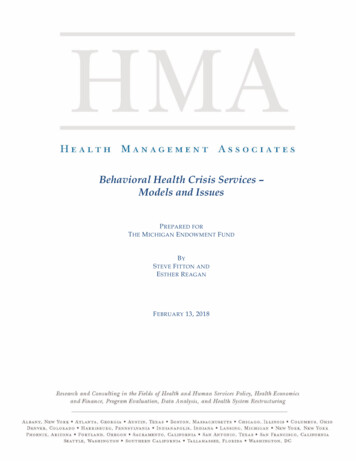
Transcription
Behavioral Health Crisis Services –Models and IssuesP REPARED FORT HE M ICHIGAN E NDOWMENT F UNDBYS TEVE F ITTON ANDE STHER R EAGANF EBRUARY 13, 2018
Behavioral Health Crisis Services – Models and IssuesFebruary 13, 2018Table of ContentsExecutive Summary. 1Standalone Behavioral Health Crisis Centers . 1Mobile Crisis Teams . 1Co-located, Dedicated Behavioral Health Crisis Emergency Services Unit . 1Behavioral Health Staffing in Hospital EDs . 2Introduction/Background . 3Behavioral Health Crisis Response Models . 4Standalone Behavioral Health Crisis Centers . 4Mobile Crisis Teams . 6Co-located, Dedicated Behavioral Health Emergency Services Unit . 7Behavioral Health Staffing in Hospital EDs . 7Moving Forward – Diving Into the Issues and Possible Strategies . 8Effective Triage and Direction into the Service System . 8Legal Challenges . 9Financial Challenges . 11Interagency Coordination . 13Care Continuum . 14Conclusion . 15End Notes . 16Health Management Associates
Behavioral Health Crisis Services – Models and IssuesFebruary 13, 2018Executive SummaryThere is general agreement that far too many persons with behavioral health (mental illness and/orsubstance use disorder [SUD]) issues are arriving in hospital emergency departments (EDs) and notbeing well served in that setting. The underlying issues interfering with the appropriate treatment ofpersons in a behavioral health crisis are complex and many. There are many large service systems thatcan be involved: physical health, emergency services, law enforcement, and certain community socialservices, in addition to behavioral health. These service systems have their own points of entry (in manycases multiple doors for the individual system) with great variation in the skills, training, and experienceof the person at the initial point of contact. There are obvious challenges around which agency shouldtake initial responsibility and how services are coordinated. Each situation requires a judgment aboutwho does what and when, as well as communication and coordination across systems and professionals.Given the breadth of the behavioral health emergency response environment, there have been multipleservice configurations designed to improve the system. Since much of this capacity is still emerging,evidence for the best approach to these services is very limited. Further, the different environments(especially urban versus rural) and community resources may result in best practices that vary.Standalone Behavioral Health Crisis CentersCrisis centers function like a behavioral health ED. They stabilize and assess persons in crisis in anenvironment conducive to their needs, resulting in better outcomes. Fewer individuals require inpatientpsychiatric treatment, and referrals are made to more appropriate settings. Crisis centers are oftenpaired with crisis residential units that provide longer term services but short of psychiatrichospitalization. There are a limited number of crisis centers in Michigan, two are operational and twoothers are in the planning stage. Some point to the law which requires ambulances to transportemergencies to hospital emergency departments (EDs) as a major impediment. While this is an issue,there are many other obstacles to developing and sustaining crisis centers.Mobile Crisis TeamsMobile crisis teams go out into the community to begin the process of assessment and definitivetreatment outside of a hospital or health care facility. These teams include a psychiatrist available bytelephone or for in-person assessment as needed and clinically indicated. Mobile crisis services can be avaluable part of a crisis service system, but they are not a singular solution.Co-located, Dedicated Behavioral Health Crisis Emergency Services UnitThis service configuration has hospitals creating a dedicated psychiatric emergency services unit. This isa standalone ED specifically for psychiatric patients. The advantages of such a unit is that staffing can betailored to the needs of this population, and the physical environment can be controlled to help alleviatestressors. This approach to the behavioral health ED problem may have limited application becausesome urban areas have many hospitals, and rural areas have the obvious volume and resource issues.Health Management Associates1
Behavioral Health Crisis Services – Models and IssuesFebruary 13, 2018Behavioral Health Staffing in Hospital EDsIncreasing behavioral health staff resources in EDs is a variation on the dedicated unit approach and cantake many forms. It can consist of in-house hospital personnel of various professional credentials,collaborative arrangements with behavioral health staff or teams from community agencies, use ofparaprofessionals as staff enhancement, and/or psychiatric or lower level professional telehealth.While there are numerous substantive issues that must be addressed to move the service deliverysystem forward, the dominant theme from our research was that the behavioral health care servicecontinuum was critical to success in responding to behavioral health crisis situations. Breakdowns at anypoint in the service array lead to dysfunction throughout the system. While the most prominentexample is a shortage of inpatient psychiatric beds, the need for outpatient behavioral health services inthe community gets equal billing. This follows the general health care principle that it is better to engageservices in the least intensive yet appropriate manner and setting for better outcomes and lower cost.Beyond the care continuum, there are many other complex, challenging issues that must be addressedin building an effective service delivery system for behavioral health crises. These include: well-designedtriage and direction into the service system; interagency coordination; financial issues, especially publicand private health insurance coverage of non-traditional crisis services; and a wide range of legal issuescovering law enforcement, Emergency Medical Services and ambulance licensing, scope of practice laws,and consumer protections for behavioral health patients.Health Management Associates2
Behavioral Health Crisis Services – Models and IssuesFebruary 13, 2018Introduction/BackgroundThere appears to be general agreement that far too many persons with behavioral health (mental illnessand/or substance use disorder [SUD]) issues are arriving in hospital emergency departments (EDs) andnot being well served in that setting. Holding behavioral health patients in EDs has been termed“psychiatric boarding” and is a growing problem with 90 percent of ED physicians reporting this reality. 1Long waits in noisy EDs may exacerbate symptoms; and often the EDs do not have the professional staffbest suited to provide services. The flip side of this is ED “streeting” where behavioral health patientsare discharged prematurely and/or without supports. In either case, “boarding” or “streeting” isdamaging to these patients. From a cost standpoint, ineffective treatment of behavioral health patientsin EDs is a poor use of resources. The ED itself is an expensive setting and can result in unnecessary andcostly admissions for public and private insurers. In short, it is the wrong place at the wrong time formany patients for lots of reasons.Behavioral health crisis centers are one alternative and an additional approach advocated as a solutionto the problems with behavioral health patients who do not need ED services and yet are waiting for thenext level of behavioral health care while in the ED. The crisis centers in operation function likespecialized behavioral health EDs. They stabilize and assess persons in crisis in an environmentconducive to their needs, resulting in better outcomes. Fewer individuals require inpatient psychiatrictreatment, and referrals are more appropriate.So why aren’t there more behavioral health crisis centers? Many point to the laws governing ambulancetransport as the root of the problem and a barrier to developing more appropriate settings and servicesystems. Michigan law and regulation requires that any emergency transport have a licensed hospital asits destination. This is the action that precedes a person in a behavioral health crisis arriving at a hospitalED, precluding immediate diversion to a crisis center. While this is the reality and a significant problemitself, it is hardly the entire story or even the most important element in the range of issues that are atthe root of this harmful situation.The underlying issues interfering with the appropriate treatment of persons in a behavioral health crisisare complex and many. For instance, there are many large service systems that may be involved. Theyinclude physical health, emergency services, law enforcement, and certain community social services inaddition to behavioral health. These service systems have their own points of entry (in many casesmultiple doors for the individual system) with great variation in the skills, training, and experience of theperson at the initial point of contact. The behavioral health system has its own complexities and issueswith service coverage and coordination across both private and public spheres. There are significantlegal issues including professional scope of practice laws, facility and service licensing (includingambulance emergency destination restrictions), and protections for patients including medical clearanceand “certifications for involuntary admissions.” Financing has its own set of challenges since insurers(public and private) have their own systems of rules that only reimburse certain services rather than thefunding capacity to serve anyone in crisis, regardless of coverage status.The various service systems potentially involved in response to emergent or urgent situations areintended to cover the diversity of difficulties that individuals can present and consequently haveHealth Management Associates3
Behavioral Health Crisis Services – Models and IssuesFebruary 13, 2018enormous collective functional span. While each system has its own specialization and ability toeffectively address problems that fit within its orbit, urgent and emergent situations can involvemultiple issues that overlap systems. A person having a psychotic episode may have physically injuredthemselves or others. That would require not only behavioral health services but physical health careand law enforcement as well. A homeless person with uncontrolled diabetes and severe depression alsorequires response from multiple systems: community social services for housing and other socialdeterminants of health, medical professionals to address the diabetes and any other physical healthissues, and behavioral health professionals to focus on the depression. These are just a couple of whatare likely an almost infinite range of problems that can be encountered. There are obvious challenges inwhich agency takes initial responsibility and how services are coordinated. Each situation requires ajudgment about who does what and when, as well as communication and coordination across systemsand professionals.Behavioral Health Crisis Response ModelsGiven the breadth of the behavioral health emergency response environment, there have been multipleservice configurations designed to improve the system. These include mobile crisis teams; behavioralhealth staffing in EDs; a co-located, dedicated behavioral health emergency services unit (alongsidetraditional EDs); and standalone behavioral health crisis centers. Much of this capacity is still emergingso evidence for the best approach to these services is very limited. Further, the different environments(especially urban versus rural) and community resources may result in best practices that vary.Standalone Behavioral Health Crisis CentersThe shorthand definition of standalone behavioral health crisis centers is that they are functionallybehavioral health dedicated EDs. A 2014 SAMSHSA report has offered a richer definition: “23-hour crisisobservation or stabilization is a direct service that provides individuals in severe distress with up to 23consecutive hours of supervised care to assist with deescalating the severity of their crisis and/or needfor urgent care. The primary objectives of this level of care are prompt assessments, stabilization,and/or a determination of the appropriate level of care. The main outcome of 23-hour observation bedsis the avoidance of unnecessary hospitalizations for persons whose crisis may resolve with time andobservation.” 2It is interesting that crisis center services as described above are almost always paired with crisisresidential units (or crisis stabilization facilities) which provide capacity for short-term stays as analternative to inpatient psychiatric hospitalization. Again, we have a useful SAMHSA definition: “a directservice that assists with deescalating the severity of a person’s level of distress and/or need for urgentcare associated with a substance use or mental health disorder. Crisis stabilization services are designedto prevent or ameliorate a behavioral health crisis and/or reduce acute symptoms of mental illness byproviding continuous 24-hour observation and supervision for persons who do not require inpatientservices.” 3While SAMHSA has provided definitions, it seems fair to observe that there appears to be a lack ofstandardization in the use of terms and the actual organization of services. Crisis stabilization programsHealth Management Associates4
Behavioral Health Crisis Services – Models and IssuesFebruary 13, 2018can refer to both short and longer-term settings. Some crisis services can be for up to 48 hours but stillnot be considered a residential or inpatient unit. Unless otherwise indicated, we will use the SAMHSAdefinitions and treat crisis centers as 23 hours or less and residential units as short stays that avoid anactual inpatient admission.The National Action Alliance for Suicide Prevention: Crisis Services Task Force in their document, CrisisNow: Transforming Services is Within Our Reach, 4 further described crisis residential units as “usuallysmall (e.g., 6-16 beds), and often more home-like than institutional. They are staffed with a mix ofprofessionals and paraprofessionals. They may operate as part of a community mental health center orin affiliation with a hospital. The Task Force recommends crisis stabilization facility function is maximizedwhen the facilities: Function as an integral part of a regional crisis system serving a whole population rather than asan offering of a single provider Operate in a home-like environment Utilize peers as integral staff members Have 24/7 access to psychiatrists or Master’s-level mental health clinicians”Crisis centers can be designated as mental health or mental health/SUD. There are different localcircumstances that lead to this distinction in breadth of service. It should be noted that the perspectiveof some experts is that it is very difficult to operate with this distinction and that an effective crisisresponse requires the capacity to address both mental health and SUD issues. The result is usually afunction of both resources and organizational considerations.In a similar vein, experts in the field stress the importance of a care continuum that can meet the rangeof needs for individuals who present for services. This includes an effective prevention and outpatientservice capacity as well as sufficient and effective inpatient psychiatric hospital capacity. Crisis centersand crisis residential units can play a critical role in this care continuum.Nationally, there appears to be considerable crisis center capacity although it is difficult to dissect howmuch of this is through crisis centers as described at the beginning of this section, crisis residential units,or crisis stabilization programs generically with a range of service types. The 2014 SAMHSA reportcovering eight states shows substantial crisis services resources in all states with most descriptionsgiving the impression that they include crisis centers. 5 Whether there is comprehensive coverage acrossthe entire state is unclear in many instances.Among the best-known organizations, RI Crisis is one of RI International’s (formerly RecoveryInnovations) business units operating in five states: Arizona, California, Delaware, Texas, andWashington State. They include crisis stabilization as a core part of their overall program. TheRestoration Center in San Antonio, Texas, is a locally developed crisis service center that includes a crisiswalk-in center and a 48-hour observation unit (with average lengths of stay about 20 hours). A finalnational example is in Idaho; crisis centers operate in three of the state’s largest cities, primarilyresponding to walk-ins and law enforcement referrals.Health Management Associates5
Behavioral Health Crisis Services – Models and IssuesFebruary 13, 2018Michigan has at least two crisis centers in operation and two that are in the planning stages. The centerwith the broadest capacity is Common Ground in Oakland County. It is a private non-profit that startedas a telephone hotline 47 years ago. It picked up the pre-admission screening function in 1995 forOakland County and, inspired by Recovery Innovations, in 2011 broadened its crisis services to include ascreening, assessment, and observation center; a residential unit; and a detoxification (detox) unit. Italso has capacity to link with a wide range of community social services on site. CEI, the communitymental health authority (and community mental health services program [CMHSP]) for Clinton, Eaton,and Ingham counties, has operated a crisis center for decades but seems to be more under the radar.They have a crisis center with six beds, with plans to expand to 10. CEI’s other crisis services are indifferent geographic locations and with plans to consolidate to the main campus. Both Network 180(Kent County CMH) and Washtenaw County are actively planning for crisis centers.Mobile Crisis TeamsThe 2014 SAMHSA report starts its definition of mobile crisis teams in this way: “The AmericanPsychiatric Association (APA) Task Force defines mobile crisis services as having the ‘capacity to go outinto the community to begin the process of assessment and definitive treatment outside of a hospital orhealth care facility,’ along with a staff including ‘a psychiatrist available by phone or for in-personassessment as needed and clinically indicated’. Mobile crisis teams provide acute mental health crisisstabilization and psychiatric assessment services to individuals within their own homes and in other sitesoutside of a traditional clinical setting.” 6The SAMHSA report continues with this additional information (with acknowledgements to othersources as well): “Although most mobile crisis teams are a link between the community and theemergency department (ED), some are co-located in facilities that have both outpatient and ED services,fewer are co-located in inpatient services and outpatient services, and some operate in more than oneof these domains. The main outcome objective of mobile crisis teams is to reduce psychiatrichospitalizations, including hospitalizations that follow psychiatric ED admission. Some mobile teams arefocused on reducing arrests of mentally ill offenders. Diversion is also a main goal of police-based teams,which may be staffed by mental health consultants or exclusively by police officers with mental healthtraining.” 7SAMHSA’s 2014 Crisis Services report showed all eight states with mobile crisis team services in place,although it is again unclear how much coverage there is in each state. Most references include mobilecrisis teams as a part of the overall system, not as the primary method of responding to behavioralhealth crises. It is noteworthy that these services are not necessarily in the home and that teams can beconsidered mobile even when housed with outpatient and hospital ED services. Some in the field believethere should be limits on these teams due to both safety and financial concerns.While mobile crisis services have been covered by Michigan’s Medicaid program for 20 years, onlyrecently (effective October 1, 2017) has it required the public behavioral health system to provide for amobile intensive crisis stabilization team for children in each geographic jurisdiction. The priority is to“avert a psychiatric admission or other out of home placement or to maintain a child or youth in theirhome or present living arrangement ” 8 Several CMHSPs had mobile crisis capacity prior to thisHealth Management Associates6
Behavioral Health Crisis Services – Models and IssuesFebruary 13, 2018requirement. Common Ground had partial county coverage 12 hours per day. Until late 2017, GeneseeCounty was the only reported 24/7 operation with full county coverage. Northern Lakes CommunityMental Health (NLCMH), a CMHSP serving six northern Michigan counties (Crawford, Grand Traverse,Leelanau, Missaukee, Roscommon, and Wexford), implemented its mobile intensive crisis stabilizationprogram during the fall of 2017 with the support of a grant from the Michigan Health Endowment Fund.Called Family Assessment & Safety Team, or FAST, services are provided on a 24/7 basis throughoutNLCMH’s service area for families with children in behavioral health crisis. 9Co-located, Dedicated Behavioral Health Emergency Services UnitIn December 2015, The Joint Commission issued a short paper that addressed the problems ofbehavioral health patients in hospital EDs along with a range of potential solutions. The range ofsolutions included hospitals creating “a dedicated psychiatric emergency services unit (a standalone EDspecifically for psychiatric patients).” 10 The advantages of such a unit is that staffing can be tailored tothe needs of this population and the physical environment can be controlled to help alleviate stressors.In late 2017, Gwinnett Medical Center in Lawrenceville, Georgia, a suburb of Atlanta, opened a new5,000 square foot specialized behavioral health unit that can hold up to eight patients at a time. Thisunit was created adjacent to the existing hospital ED, at a cost of nearly 3 million. The hospital reportsthat they will contract with a full-time staff of behavioral health care professionals to work with some ofthe system’s ED nurses who will be assigned to provide for the medical care needs of the patients. 11This approach to the behavioral health ED problem may have limited application. A very large medicalcenter like Gwinnett’s, which dominates a geographic area, is the most likely location for such a unit in ahospital alongside an existing ED. Urban areas with many hospitals, where the behavioral health EDpatients are more dispersed, face a resource concentration issue. Rural areas have obvious volume andresource issues as obstacles. Also, there are questions about the quality of medical services for physicalhealth issues in these behavioral health units.Behavioral Health Staffing in Hospital EDsIncreasing behavioral health staff resources in EDs is a variation on the dedicated unit approach and cantake many forms. It can consist of in-house hospital personnel of various professional credentials,collaborative arrangements with behavioral health staff or teams from community agencies, use ofparaprofessionals as staff enhancement, and/or psychiatric or lower level professional telehealth.It is likely that these types of arrangements are prevalent in various forms throughout the nation. Forexample, in Ingham County, there are different service configurations with each of the two localhospitals. In one, the hospital itself has an in-house behavioral health team that initially providesservices in the ED. In the other hospital, the local public CMHSP embeds a team in the ED from 2 pm to 2am each day.The Michigan Health Endowment Fund is itself funding projects that aspire to increase behavioral healthcapacity in hospital EDs. One approach is with Pine Rest Christian Mental Health Services, which hasproposed to educate staff and provide telephonic consultation and case management services toHealth Management Associates7
Behavioral Health Crisis Services – Models and IssuesFebruary 13, 2018hospital EDs across west Michigan. Their focus is on children presenting with behavioral health issues.The Michigan Department of Health and Human Services has just begun a project to explore partnershiprelationships between hospitals and public community behavioral health agencies to provideCommunity Living Support services in EDs and inpatient psychiatric units. This would enable thedeployment of trained paraprofessional staff in these hospital settings for appropriate support topatients and relief to other hospital staff.There are, no doubt, almost endless examples of variations on this approach across the country. Thissolution concedes that the hospital ED is not an ideal environment for behavioral health patients butseeks to provide higher quality and more timely services in that context.Moving Forward – Diving into the Issues and Possible StrategiesThe notion that developing behavioral health crisis center capacity will somehow solve the problem ofbehavioral health patients in hospital EDs seems simplistic even if the transportation of those patients tocrisis centers could be arranged. This is a tremendously complex problem. Hopefully, this paper haseffectively described some of that complexity ranging from the variety of needs of the presentingindividuals themselves to the many service systems and local variability of resources. This section hasthe modest aim of discussing the many challenges and offering potential strategies for forwardmovement. Overriding themes are the need for a care continuum and coordination across servicesystems.Effective Triage and Direction into the Service SystemAs observed earlier, there are numerous possible initial methods of contact in behavioral healthemergencies. Behavioral health agencies have their own contact points, and public systems typicallyhave a legal mandate for a crisis hotline or call center. Emergency response systems have 911 callcenters. There are now also 211 call centers for referral to community resources. Law enforcement issometimes the first point of contact whether in response to a call from the community or involvementin an actual situation. Finally, individuals can be referred by other professionals or simply find their wayto services on their own.Each of these contact methods involves personnel with different training, knowledge, and skills. Somemay be volunteers. Others are trained but in the context of their position and role. A 911 operator hasvery specific training and priorities around emergency situations: they are likely to call on EmergencyMedical Systems (EMS) or law enforcement, or both, to respond. Law enforcement officers will generallystart from a criminal justice orientation, but those trained in behavioral health issues will have a broaderperspective. EMS will have different capacity based on the level of personnel, with paramedics havingmore training than Emergency Medical Technicians (EMTs). A crisis hotline staff person is likely tohandle a call very differently and isn’t predisposed to take any action other than to empathize and talk.Hopefully this representative but hardly exhaustive list of possible initial points of contact providessome sense of the range of perspectives that exist as individuals enter “the system”.Health Management Associates8
Behavioral Health Crisis Services – Models and IssuesFebruary 13, 2018Enhancing the skills of the personnel involved and more effective cross-training across service systemshave potential benefit in more appropriate direction to services. A paramedic with enhanced trainingand telehealth support could evaluate an emergency situation and rule out physical health involvementand direct the patient to a crisis center w
Behavioral health crisis centers are one alternative and an additional approach advocated as a solution to the problems with behavioral health patients who do not need ED services and yet are waiting for the next level of behavioral health care while in the ED. The crisis centers in operation function like specialized behavioral health EDs.
